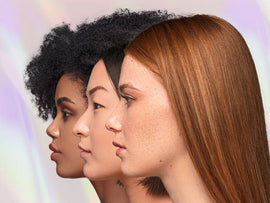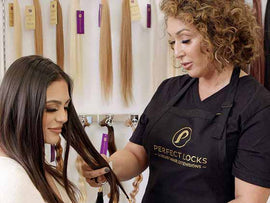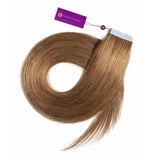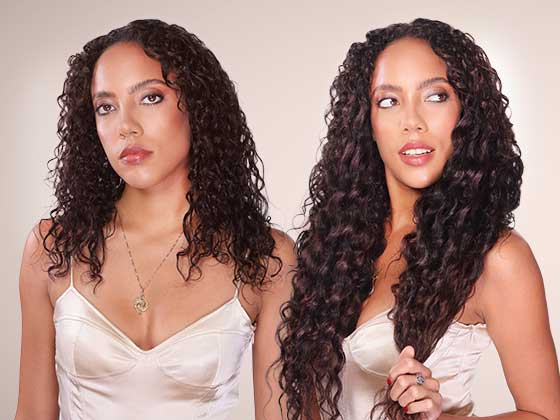When it comes to curly hair, finding the right extension method can make all the difference in achieving the desired look. Before getting hair extensions, it's essential to understand the unique needs of your hair and choose a method that complements its texture and style.
Understanding Curly Hair
Curly hair has its own set of characteristics, including natural bounce, volume, and texture. However, managing curly hair can be challenging due to factors like frizz, dryness, and tangles. When selecting extension methods for curly hair, it's crucial to consider several factors to ensure compatibility and minimize damage.
Different Extension Methods
Below are various extension options for women with curly hair:
Clip-in extensions
Clip-in extensions are temporary and easy to apply, making them a popular choice for adding volume and length to curly hair. However, they may not blend seamlessly with natural curls and can be noticeable if not properly installed. Clip-in extensions come in various lengths, colors, and textures, allowing users to customize their look according to their preferences. They are also versatile, allowing for easy removal and reapplication as needed.
Below are the different extension methods and explanations for which is best suited for curly hair.
Tape-in extensions
Tape-in extensions offer a more permanent solution and lie flat against the scalp, providing a natural appearance. While suitable for straight and wavy hair, they may not be ideal for very curly hair, as the tapes can become visible when the curls are in motion. Tape-in extensions require professional application and regular maintenance to ensure they remain secure and undetectable. With proper care, tape-in extensions can last for several weeks before needing to be replaced or adjusted.
Sew-in (weave) extensions
Sew-in extensions involve braiding the natural hair and attaching wefts of hair extensions using thread and a needle. This method offers durability and versatility, making it suitable for various hair types, including curly hair. However, improper installation or tight braids can cause tension and damage to the natural hair.
Sew-in extensions come in different textures and lengths, allowing users to achieve a seamless blend with their natural curls. They can be styled in various ways, including updos, ponytails, and braids, without causing damage to the extensions or natural hair.
Micro-link (micro-bead) extensions
Micro-link extensions use small beads to attach individual strands of hair extensions to the natural hair. This method allows for natural movement and flexibility, making it a popular choice for curly hair. However, frequent adjustments may be required to prevent tangling and breakage.
Micro-link extensions come in different sizes and colors, allowing for a customized and natural-looking blend with natural hair. They are suitable for individuals with active lifestyles as they can withstand heat, sweat, and water without slipping or causing discomfort.
How to Choose the Best Extension Method for Curly Hair
When choosing an extension method for curly hair, several factors should be taken into account to ensure the best outcome. Here are the key factors to consider:
Texture of natural hair
The texture of your natural hair plays a significant role in determining which extension method will blend seamlessly. Curly hair comes in various textures, from loose waves to tight coils, so it's essential to choose extensions that closely match your natural curl pattern for a cohesive look.
Desired style and volume
Consider the style and volume you want to achieve with your extensions. Some methods, like clip-in extensions, are ideal for adding temporary volume and length for special occasions, while others, like sew-in extensions, offer more permanent solutions for everyday wear.
Maintenance and upkeep
Different extension methods require varying levels of maintenance and upkeep. Clip-in extensions are easy to install and remove, making them ideal for those who want a low-maintenance option. On the other hand, sew-in and tape-in extensions may require regular maintenance appointments to adjust and tighten the weave as your natural hair grows.
Budget
Extension methods vary in cost, so it's essential to consider your budget when choosing the right option for you. Clip-in extensions are generally more affordable upfront but may need to be replaced more frequently than other methods. Sew-in and micro-link extensions tend to be more expensive initially but can last longer with proper care.
Comfort and manageability
Think about how comfortable and manageable the extensions will be for your lifestyle. Sew-in and micro-link extensions allow for more natural movement and flexibility, making them comfortable for everyday wear. However, some people may find them challenging to manage during activities like swimming or exercising.
Tips for Caring for Curly Hair Extensions
Caring for curly hair extensions is crucial to maintain their appearance and prolong their lifespan. Here are some tips to ensure your curly hair extensions stay looking their best:
Use the right products
Use sulfate-free shampoos and conditioners specifically formulated for curly hair extensions. These products help retain moisture and prevent frizz without stripping the hair of natural oils.
Detangle gently
Use a wide-tooth comb or your fingers to detangle your curly hair extensions, starting from the ends and working your way up to the roots. Avoid brushing curly hair when dry, as it can cause breakage and disrupt the curl pattern.
Moisturize regularly
Curly hair tends to be drier than straight hair, so it's essential to moisturize your extensions regularly. Apply leave-in conditioners or hair oils to keep the curls hydrated and nourished.
Avoid heat styling
Limit the use of heat-styling tools such as flat irons and curling wands on your curly hair extensions. Excessive heat can damage the hair fibers and cause the curls to lose shape. If you must use heat, always use a heat protectant spray beforehand.
Protect your hair while sleeping
To prevent tangling and friction, sleep with your curly hair extensions in a loose braid or pineapple style. You can also use a silk or satin pillowcase to minimize friction and help retain moisture.
Avoid harsh chemicals
Avoid using harsh chemicals such as bleach or ammonia on your curly hair extensions, as they can weaken the hair fibers and cause irreversible damage. If you want to change the color of your extensions, opt for gentler dyeing methods such as semi-permanent or demi-permanent colors.
Regular maintenance
Schedule regular maintenance appointments with your hairstylist to ensure your curly hair extensions stay in good condition. This may include tightening sew-in extensions, reapplying tape-in extensions, or adjusting.
Conclusion
Finding the perfect extension method for curly hair requires careful consideration of various aspects. While each method offers its own benefits, sew-in (weave) extensions are often the preferred choice for curly hair due to their durability and versatility. With proper care routines, curly-haired individuals can enjoy beautiful and natural-looking extensions that enhance their unique style.
















